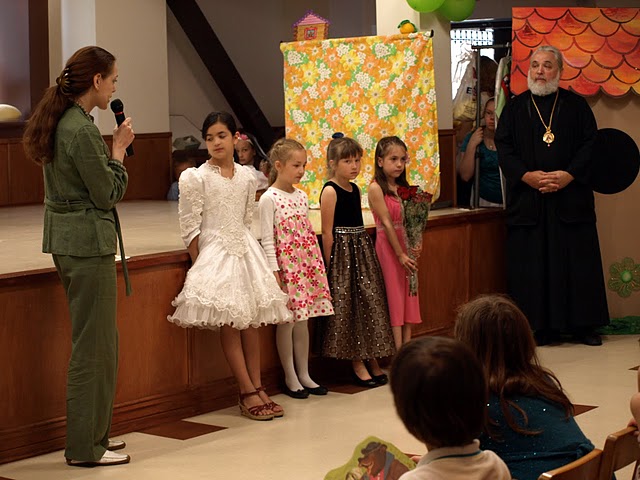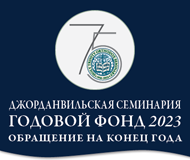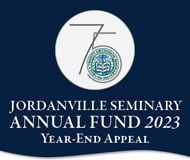News
-

On Saturday, 18 June, the annual graduation at the Church Parish School of A.S. Pushkin, was held at the St. Nicholas cathedral in Montreal
30 June 2011
On Saturday, 18 June, the annual graduation at the Church Parish School of A.S. Pushkin, which exists at the parish since 1937, was held at St. Nicholas cathedral in Montreal in order to mark the ending of the school year.
A solemn prayer service for the occasion was conducted by His Eminence, the Very Most Reverend Gabriel, Archbishop of Montreal and Canada. Vladyka Gabriel, being the principal of the parish school at his cathedral, pays much attention to orthodox upbringing and education. Addressing the parents, teachers, and all those present, His Eminence, Archbishop Gabriel, in particular, noted that care for orthodox parish schools is the primary task of every parish in the Russian Diaspora, because in case of neglect, our parishes will face gradual extinction. Vladyka called upon the parents to do everything possible in order to make sure the children do not lose the connection with their native language and the great culture of Historical Russia. Vladyka also expressed the hope that the number of students at the cathedral parish school – where there are more than 70 students of different ages currently – will continue to grow with each year.
After the prayer service, students received certificates and awards, then there was a concert.
After the concert, everyone was invited to a traditional meal.
Here are the photos from the event, prepared by the teacher of Russian history and Church Slavonic language, E.M. Bormotova.
-

FOR THE DAY OF THE HOLY TRINITY
11 June 2011
Three times in the history of our salvation the Third Hypostasis of God – the Holy Spirit – visibly, audibly, and palpably manifested Itself “Who with the Father and the Son together is worshipped and glorified,” for the old testament world knew always the Holy Spirit “Who spoke by the prophets”: He was “in every pure soul, without Him no truly good work was ever completed” (Bishop Innocent of Kherson). The Holy Spirit invisibly dwelt in the Holy of Holies of the Jerusalem temple, but He departed when the Lord “gave up the spirit” on the Cross; as the mark of departure and the harbinger of the destruction of Jerusalem served the great sign: “…the veil of the temple [separating the Holy of Holies – YM] was rent in two, from the top to the bottom” (Matthew 16:37-38). It is essential that the description of this event we find not only in the Gospels, but also in the judean records, where a fairly exact date of what happenned is also given as the forty years before the destruction of the temple, i.e. in the 30th year after the Nativity of Christ, in the year of crucifixion.
The fullness of the Trinity was given to us in Theophany (Baptism of the Lord) at the Jordan; later on the Holy Spirit illumined the apostles with the uncreated light of Tabor in the miracle of Transfiguration; and, finally, “bestowing the tongues of fire, He called all into unity” in the Upper Room on Sion on the day of Pentecost.
Yet the very ability of men to receive the gifts of the Holy Spirit possesses as its source the meeting of the Life-creating Trinity in the image of Three Travelers by forefather Abraham, the friend of God.
“And the Lord appeared unto him in the plains of Mamre: and he sat in the tent door in the heat of the day; And he lifted up his eyes and looked, and, lo, three men stood by him: and when he saw them, he ran to meet them from the tent door, and bowed himself toward the ground, And said, My Lord, if now I have found favour in thy sight, pass not away, I pray thee, from thy servant” (Genesis 18:1-3).
As it follows from the Scriptures, the Friend of God addressed the Three Men in singular person.
The Mamre oak grove was situated on the slopes of the hollow to the west of Hebron of those days. The Oak of Mamre (in other words Abraham’s), under the shade of which the forefather received the Mystical Guests, survived miraculously to our days, having given life to multiple shoots.
“Old, very old is this Patriarch of the vanished forests of Palestine, – is said in the travelling notes of the famous Russian explorer and ethnographer A.V. Eliseev (With the Russian pilgrims to the Holy Land in the spring of 1884, St. Petersburg, 1885). – Many parts of it have dried, but it still lives, and though not every year, but does bear fruit… The venerable oak, according to my most thorough calculations, is in no way less than 4 to 5 thousand years old, judging by the number of the lairs of its triple and quadruple branches, the cuts of which I was able to observe.”
Christian writers of the XVII century mention the Oak of Abraham in their “travels,” it is notable that the location pointed out by them then matches exactly the current location of the tree.
The famous igumen Daniel, who visited the Holy Land during the time of the Jerusalem’s king Baldwin I, tells: “And from Bethlehem, facing south is Hebron, the cave of Abraham and the oak of Mamre. …The oak is close to the way, there walking on the right hand side; and it stands beautiful on the high mountain. …And here stood the tent of Abraham near the oak, facing east. And the oak is not very tall, spread out and is thick with branches, and there is much fruit on it.”
The piece of land, upon which the Oak of Mamre grew, was – together with the other most important parcels on the Holy Land – purchased for the Russian ownership by the ever-memorable archimandrite Antonin (Kapustin) – the director of the Russian Spiritual Mission.
The parcel “Khirbet-en-zibta,” pointed out by tradition as the biblical grove of Mamre, used to belong to the family of some Ibrahim Shalludi. The history of the purchase of the Oak deserves a more thorough look at it.
Only the subjects of the Ottoman empire were allowed to buy land openly in these regions. It was here that sometime famous mission translator Iakov Yegorovitch Khalebi played his role.
Iakov Yegorovitch adorned my live, – Fr. Antonin Kapustin, not inclined to emotional exclamations, spoke of him.
“In the winter of 1868, he [Khalebi – YM] appeared in Hebron under the guise of a merchant from Aleppo. Iakov Yegorovitch, carefully playing his role, as though buying merchandise, mingling in the midst of Hebron merchants, spent a long time there. Finally, after long and fatigueing negotiations, combinations, precautions, countless bribes, Shalludi sold the parcel with the Oak to Iakov Yegorovitch, a lawful ownership deed being drawn up for the transaction.
I had to hear about his meeting with Fr. Antonin in Jerusalem form eyewitnesses. Fr. archimandrite waited for Khalebi, who arrived, at the entrance into a hall, on the stairway, in the Mission building. As soon as Iakov Yegorovitch, still from below, saw the figure of Fr. Antonin, he joyously ran up the stairs, waving the deed and shouting: ‘the Oak is Russian, the Oak is Russian!’ Fr. Antonin joyously opened his embrace to him and kissed him.” (Archimandrite Cyprian Kern. Fr. Antonin Kapustin. Belgrade, 1934).
On 22 May, 1871, at the Oak of Mamre first Liturgy was served, and to this day, on the third day of the feast of Pentecost, the clergy of the Mission serves Liturgy upon a movable altar table under the tree, from which all of our trinity birches take our beginning.
The buiding of the large church with three altars dedicated to the holy Forefathers was started only in 1907, while archimandrite Leonid (Sentsov) was the director of the Mission. The work was completed only in 1925.
“It is easy to reestablish how the travellers journeyed, – says a guide “Holy Land” (Paris, 1960). – Most likely, they descended into the Hebron Valley from the Northwest, and Abraham, who sat in the shadow of his tent in the midday heat, saw them on the slope of the mountain, where there now stand Russian cathedral and a house for pilgrims.”
-
Patriarch’s greeting of archbishop of Montreal Gabriel on his 50th birthday
5 June 2011
His Holiness, Patriarch of Moscow and All Russia Kyrill congratulated archbishop Gabriel of Montreal and Canada with his 50th birthday.
To The Very Most Reverend Gabriel, archbishop of Montreal and Canada
Your Eminence!
I congratulate you with your jubilee heartily.
During the years of your zealous ministry for the good of the Church of Christ, you, by the mercy of God, had an opportunity to fulfill many obediences, showing an example of humble and meek fulfillment of the Lord’s will and the decisions of the Hierarchy. Having been raised in the best traditions of the Holy Trinity Seminary in Jordanville, you dedicated a significant portion of your life to teaching in this famous centre of orthodox spiritual education.
By the most wise Providence of the Master of the world, you soon became a successor to the apostles, “as good steward of the manifold grace of God” (1 Peter 4:10). Now you administer the Diocese of Montreal and Canada, bearing witness to the truth and beauty of the orthodox faith, “warning every man, and teaching every man in all wisdom; that we may present every man perfect in Christ Jesus” (Col. 1:28).
In attention to your diligent labours and to the significant jubilee celebrated by you I consider it proper to award you with the medal of St. Sergius of Radonezh, of the II degree.
By the intercessions of the Heavenly Mistress, may the All-mercifull Saviour keep you in good health and good spirit for many and good years, giving you the strength for the carrying out of the responsibility of hierarchical ministry.
With love in the Lord
+KYRILL, PATRIARCH OF MOSCOW AND ALL RUSSIA
The clergy and faithful of the Canadian diocese, with spiritual joy join the congratulations and good wishes, expressed in the letter of His Holiness, Kirill Patriarch of Moscow and All Russia, addressed to our Hierarch, the Very Most Reverend Archbishop Gabriel.
Many and good years, dear Vladyka






